by K. A. Kimbrough and C.E. Swift1 (10/09)
Quick Facts…
- Hardy lavender varieties thrive in Colorado’s USDA Hardiness Zones 5 through 7.
- Lavender grows best in full sun and slightly alkaline soils, which makes it a perfect plant for Colorado.
- Lavender comes in a variety of colors including white, pink, blue, violet and all shades of purple.
- Harvest flowers before they have fully opened for best results when drying.
- Lavender has no major pests in Colorado but can develop root rot if drainage is
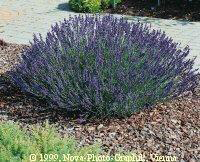 |
| Figure 1: Lavandula angustifolia ‘Hidcote’. |
Prized for its fragrance, medicinal properties and beautiful color, lavender has been one of the
most popular herbs for centuries. Lavender’s versatility has made it a valued plant for households across the world. Its fragrance, leaf color contrast, and water-wise properties make it a great choice for Colorado gardeners. Lavender originated in the Mediterranean region of Europe. Today, lavender is grown around the world where the climate conditions are similar to that region. Major commercial growing areas are located in France, England, New Zealand and Australia. Here in North America, lavender is grown as a cash crop in Washington State, New Mexico and Texas.
Selecting Plants
Lavender is a semi-woody perennial sub-shrub. Its grey to green foliage has the potential to stay evergreen throughout the year depending on location and weather. A member of the plant family Lamiaceae (mints), it has square stems and distinctive fragrances.
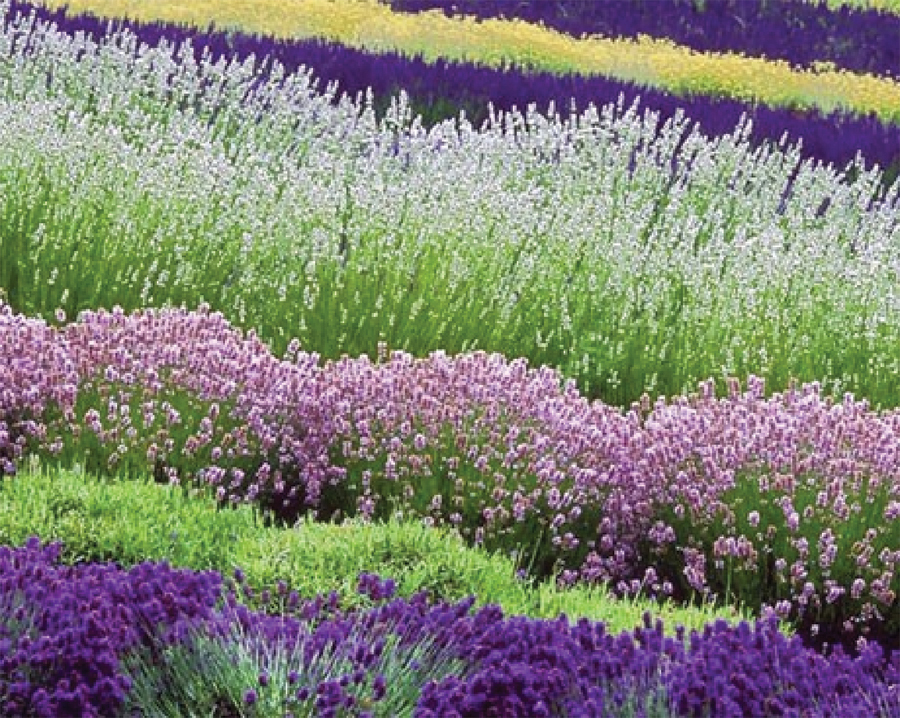 |
| Figure 2: Various colors of Lavender. Photo courtesy of Sequim Lavender Festival – Don Paulson. |
Two types of lavenders grow well in Colorado. The first is Lavandula angustifolia or English lavender. It is hardy to Zone 5 and often blooms twice in one season. There are hundreds of varieties of English lavender available depending on the color and size of plant desired. The second is a hybrid of L. angustifolia and L. latifolia. It is commonly referred to as a lavandin. Lavandins are generally larger plants that bloom only once later in the summer and produce sterile seed. The Lavandins produce larger quantities of essential oil but not as high quality as the English lavenders. Both types of lavenders have a place in landscapes and as a cash crop. In this fact sheet, the word lavender will refer to both types of lavenders. Note that French and Spanish lavenders are not cold hardy in Colorado but can be used as annuals in containers and outdoor beds.
When planting L. angustifolia or its cultivars, be sure nursery stock has been propagated vegetatively from cuttings, not started from seed. English lavenders do not always come true from seed potentially resulting in highly variable height, width, color, bloom time and other characteristics. Lavandins are sterile and can only be propagated vegetatively and are much taller than the English as shown in Figures 3 and 4.
Planting Lavender
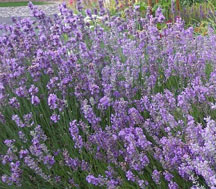 |
| Figure 3: Lavandin ‘Provence’. Photo courtesy of K. Kimbrough. |
Lavender can be planted from spring through fall in Colorado. Research conducted by New Mexico State University Sustainable Agriculture Science Center in Alcalde, NM has shown that fall-planted lavender survives better, establishes more quickly, and produces more flowers the following season. Choosing the size of plant depends on when planting will occur. Fall planted lavenders should be in 4 inches or larger sized pots with an established root system to ensure survival over the winter. Watering during the winter will increase survival. Spring-planted lavender plants can be smaller as they will have a long season in which to establish the root system.
Lavenders prefer full sun and an alkaline soil with very little organic matter. Heavy soils may need to be amended prior to planting to insure good drainage. The smaller size (one-quarter inch) bark mulch performs well as a soil amendment. Apply 1inch of this mulch and uniformly till it in to a depth of 6 to 8 inches. The use of sand or gravel as a soil amendment in clay soils may create an even greater drainage problem. See fact sheet 7.235, Choosing a Soil Amendment, for further information.
When planting lavender as a crop, spacing depends on the size of the cultivars and ranges from 2
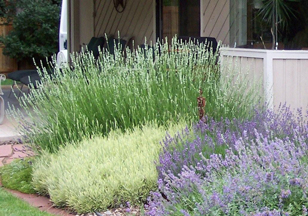 |
| Figure 4: The tall white lavandin in the background is ‘White Grosso’. In front of it are the English varieties ‘Goldberg’ and ‘Mitcham Grey’. Photo Courtesy of K. Kimbrough. |
to 3 feet within the row and 3 to 6 feet between the rows. Lavender is not competitive and does not respond well to weed pressure. If growing lavender in a field, landscape fabric is highly recommended as a weed barrier. If growing lavender as an organic crop, be sure to check the National Organic Program for the List of Allowed and Prohibited Substances.
Even though lavender is drought tolerant, adequate supplemental irrigation is required for optimum establishment, satisfactory landscape quality and maximum production. Irrigation amounts and scheduling will vary according to soil type, climatic zone, and weather patterns. Because of Colorado’s low humidity, overhead watering works just as well as drip irrigation. In general, water once or twice a week immediately after planting, until plants are established. Water mature plants every two to three weeks until bud formation, then once or twice weekly until harvest. The use of landscape fabric will also cut down water requirements significantly. Apply rock or bark mulch over the landscape fabric but away from the crown of the lavender plant. The root zone should not be allowed to dry out during winter. Fabric row covers can be used during the winter to protect the new plants from wind and heavy snow. See fact sheet 7.211, Fall and Winter Watering, for details on winter watering in Colorado.
Propagation
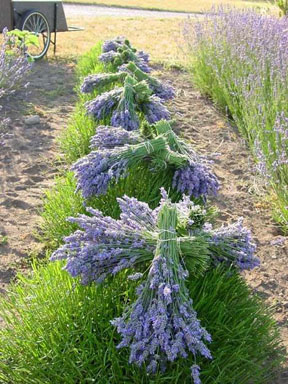 |
| Figure 5: Photo courtesy of Lavender Wind Farm. |
The best time to take cuttings from lavender plants is right after they have bloomed. Take cuttings from stems with no flower buds on them. Remove leaves from the bottom half of the cutting and insert it into well-draining sterile potting soil or horticultural vermiculite. Rooting hormones are not necessary. Be sure the cuttings are labeled as to cultivar name and date the cutting was collected. Water well and mist regularly. They should root in about three weeks. Transplant rooted cuttings into pots 2 to 4 inches in diameter. Once the plants have developed a vigorous root system they can be planted in the garden.
Pruning and Harvesting Lavender
Lavender responds well to pruning. It flowers on new growth so plants should be pruned every year after it’s established. Pruning should take place when green leaves start to emerge from the base of the plant in the spring. Remove approximately one third of the top. Pruning keeps the plant from splitting open and becoming too woody. Harvest the lavender stems in the morning hours when the oils are the most concentrated and when approximately 50 percent of the flower buds have opened.
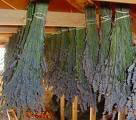 |
| Figure 6: Photo courtesy of Lavender Wind Farm. |
Use a sickle or pruning shears to cut stems as long as possible. Form bundles of 50 to 100 stems and secure them with rubber bands (Figure 5). Rubber bands will contract when the stems dry out. Dry the harvested lavender in a cool, dark place where there is good air circulation (Figure 6).
Pest and Disease Problem
Lavender has very few pest or disease problems, but it is susceptible to soil diseases such as Phytophthora. Do not over-water or allow water to stand around plants. Heavy infestations of grasshoppers can reduce yields but will probably not kill plants outright. In some areas, deer or elk may damage plants by browsing or trampling.
Reference Books and Articles
Upson, T. and Andrews, S. 2004. The Genus Lavandula. Timber Press, Inc.
McNaughton, V. 2000 – Lavender, the Growers Guide. Timber Press, Inc.
Kourik, R. 1998. The Lavender Garden – Beautiful Varieties to Grow and Gather. Chronicle Books.
Evelegh, T. 2001. Lavender; Practical Inspirations for Natural Gifts, Country Crafts and Decorative Displays. Lorenz Books.
Beus, C. 2006. Growing & Marketing Lavender, Washington State University Extension, June 2006
Lavender Production, Products,
Markets, and Entertainment Farms, National Sustainable Agriculture Information Service.
1K. A. Kimbrough, president, Western Slope Lavender Association and Colorado State University master gardener; and C.E. Swift, Extension horticulture agent, Tri River Area, Grand Junction, CO. 10/09.
Colorado State University, U.S. Department of Agriculture and Colorado counties cooperating. CSU Extension programs are available to all without discrimination. No endorsement of products mentioned is intended nor is criticism implied of products not mentioned.
Go to top of this page.





